|
Thesis Statement
The thesis will focus on an urban element which is back alleys. Since there is a lack of public space within Hong Kong, I would like to explore the methodology of creating public space in back alleys. Environmental consideration of back alleys will also be explored to optimize the conditions.
What & Why
In Hong Kong, there is around 7000 people who crowded in every square kilometer in 2016. Facing the problem of overcrowding, land cost becomes to be too valuable and the land becomes treasure for us. It seems that we need to make good use of every single inch of space. In the late nineties, each Hong Kong resident had only 1.5 square meters of public space while each Singaporean had 4.5 square meters. In some high density district like Mongkok, each Hong Kong resident had only 0.5 meter of public space. In such a high property price and dense city, how can we further extend our public spaces?
Towards the government, cramped back alleys are places which filled with trashes and offensive part in fascinating metropolis. However, towards the city user, some back alleys not only act as a short cut for pedestrian but also gathering spaces. Back alleys become a new opportunity for the extension of their public spaces.
In 2012, a project called STAG was launched in Hong Kong. The member of the STAG project demonstrates that the city created by the developers should not be perceived as a limitation of people’s appropriation in back alleys of Hong Kong. In fact, most public spaces are taken over and strictly regulated by commercial companies and government authorities. The shopping malls are not real public spaces because they do not allow free appropriation of the city user.
“There must be a clear demarcation between what is public space and what is private space. Public and private spaces cannot ooze into each other as they do typically in suburban settings or in projects.” ― Jane Jacobs
Hong Kong’s back lanes are one of the edge public spaces, while “edge of public spaces” is the space that belong to the public domain are in fact not planned nor designed for public use. Facing the blurred situation, there is a good opportunity to turn the “edge public space” into the “proper public space”.
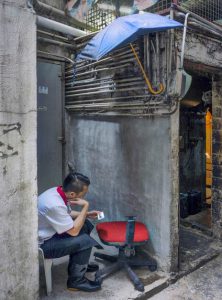 Figure 1. Worker takes a rest at the back alleys. Figure 1. Worker takes a rest at the back alleys.
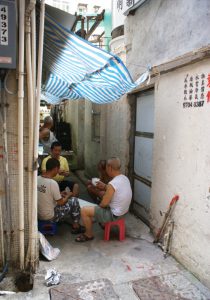 Figure 2. Back alley becomes a gathering space. Figure 2. Back alley becomes a gathering space.
How
There are three ways to create public spaces at the back alleys. Urban infill concepts are applied to occupy the residual spaces between buildings
For existing building:
1.Creating a vertical public space in a narrow back alleys.
Since some of the back alleys are relatively narrow, the design would be limited by the width of back alleys. The elevated public space would be suggested to create public space. For example, The Keret House by Jakub Szczesny and the project of “live Between Buildings” by Mateusz Mastalski and Ole Robin Storjohann. Although the projects are not for public spaces, the idea is that the house can be built between the buildings. The existing buildings provide lateral support while a public space is developed vertically. In this method, it does not connect to both sides of building.
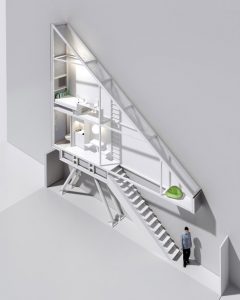
Figure 3. Keret House by Jakub Szczesny
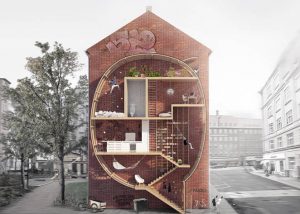
Figure 4. The project of “live Between Buildings”
by Mateusz Mastalski and Ole Robin Storjohann
2.A public space connects two existing buildings.
The idea is that public space are built between two existing buildings, while the public area can connect both sides of the building. Thus, Occupants within those buildings can use the public space.
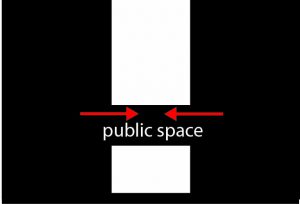
For the new building:
3.Widen the ground floor of new building.
New building can be designed to be set back in order to widen the back alleys. There would be more potential to the design of public space on the ground floor.

Outline of research
-The current situation of back alleys in Hong Kong
-The typology of back alley
-Case study of architecture between the existing buildings
-The regulation for back alley.
-The method of optimizing the condition of back alley. (vertical and horizontally)
-The environmental impact after built. For example, day lighting, ventilation.
Potential site
The potential sites would be situated at Sai Ying Pun where involves narrow and wide back alleys. The wide back alleys would be in On Ning Ln. It is more reasonable to test out different strategies according to different situations of the back alley.
Bibliography
Borio, Geraldine and Caroline Wuthrich. Hong Kong in-between. Hong Kong: Parallel Lab, 2015
Dezeen. “World’s narrowest house by Jakub Szczesny”. Accessed November 04, 2016. http://www.dezeen.com/2012/10/31/worlds-narrowest-house-by-jakub-szczesny/.
Jacobs, Jane. The Death and Life of Great American Cities . New York: Random House, 1961.
STAG. “STAG story”. Accessed November 04, 2016. http://www.staghk.org/story/.
Treehugger. “Skinny micro-housing designs lets you live in between buildings”. Accessed November 04, 2016. http://www.treehugger.com/green-architecture/live-between-buildings-micro-housing-mateusz-mastalski-ole-robin-storjohann.html.
The Hidden Ingenuity of Hong Kong’s cramped back alleys. Accessed November 04, 2016. http://www.citylab.com/housing/2016/02/the-hidden-ingenuity-in-hong-kongs-cramped-back-alleys/459390/.
[公共空間] 學生異想 倡工廈後巷互通. Accessed November 04, 2016. http://www.hk01.com/%E7%A4%BE%E5%8D%80/27467/-%E5%85%AC%E5%85%B1%E7%A9%BA%E9%96%93-%E5%AD%B8%E7%94%9F%E7%95%B0%E6%83%B3-%E5%80%A1%E5%B7%A5%E5%BB%88%E9%96%93%E5%BE%8C%E5%B7%B7%E4%BA%92%E9%80%9A.
美國活化後巷: 藝術改造、辦音樂派對、戶外用餐,香港可借鏡?. Accessed November 04, 2016. http://www.hk01.com/%E7%A4%BE%E5%8D%80/35646/%E7%BE%8E%E5%9C%8B%E6%B4%BB%E5%8C%96%E5%BE%8C%E5%B7%B7-%E8%97%9D%E8%A1%93%E6%94%B9%E9%80%A0-%E8%BE%A6%E9%9F%B3%E6%A8%82%E6%B4%BE%E5%B0%8D-%E6%88%B6%E5%A4%96%E7%94%A8%E9%A4%90-%E9%A6%99%E6%B8%AF%E5%8F%AF%E5%80%9F%E9%8F%A1-.
|
One Comment